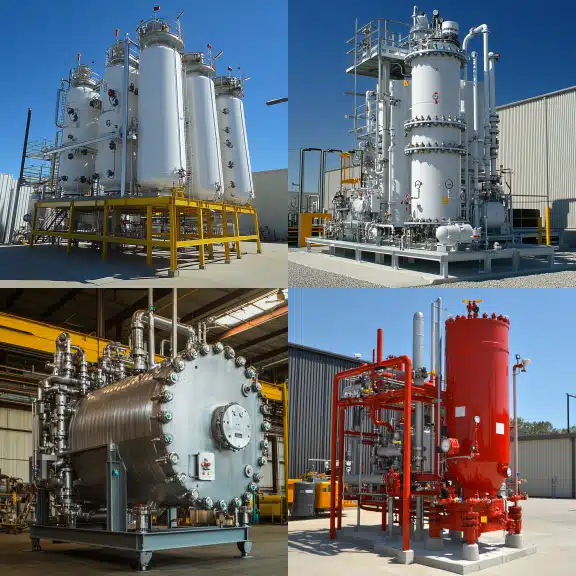
A vertical 3-phase separator is a pressure vessel designed to efficiently separate oil, water, and gas into three distinct phases. These separators are ideal for operations with limited space and high-pressure environments. Regular maintenance and proper design choices are crucial for ensuring optimal performance and reliability.
The Basics of a Vertical 3-Phase Separator
At Red River, we take pride in manufacturing quality pressure vessels and supporting our customers in understanding their functionality. One essential piece of equipment is the vertical 3-segment separator a cornerstone in oil and gas operations.
What is a Vertical 3-Phase Separator?
A vertical 3-phase separator is a pressure vessel designed to efficiently separate oil, water, and gas into three distinct phases. This separator is essential in industries such as oil and gas, where managing mixed fluid streams is crucial for operational efficiency. Its vertical design allows for optimized space usage, making it ideal for offshore structures and compact environments.
The separator operates using gravity separation. As the combined fluid enters the system, heavier water settles at the bottom, oil forms a middle layer, and lighter gas rises to the top. This natural process ensures effective separation and proper handling of all three components.
Key Components of a Vertical 3-Phase Separator
To fully understand how vertical 3-phase separators function, it’s important to know their key components:
- Inlet Diverter: Directs incoming fluid and separates the gas phase from the liquid mixture.
- Weir Plates: Retain liquid layers, ensuring the effective separation of oil and water.
- Mist Extractor: Located at the top, it captures any liquid droplets in the gas before they exit the separator.
- Drainage System: Positioned at the bottom, this ensures water is properly removed from the separator.
Each component plays a vital role, working together to deliver precise and reliable separation.
Importance of Using Vertical 3-Phase Separators in Industry
Understanding the functionality of vertical 3-phase separators is crucial for industries that require efficiency and reliability. These systems are widely used in oil and gas, petrochemical, and wastewater treatment facilities to manage mixed fluids daily.
One of their key advantages is their compact design, which minimizes space requirements without sacrificing performance. This makes them ideal for offshore and confined operations. Additionally, they help reduce operating expenses and enhance safety by effectively managing fluid separation.
The Working Principle of a Vertical 3-Phase Separator
How a Vertical 3-Phase Separator Separates Oil, Water, and Gas
When combined fluid enters the separator, it first passes through the inlet diverter. This step slows the flow, allowing water to settle at the bottom, oil to form a middle layer, and gas to rise to the top. This stratification ensures that each phase is correctly extracted and directed for further processing.
Step-through-Step Process of Vertical three-Phase Separation
- Inlet Diverter: Slows down the incoming fluid and begins initial separation.
- Gravity Separation: Water, being denser, settles at the bottom, oil forms a middle layer, and gas rises to the top.
- Mist Extractor: Removes any remaining liquid droplets from the gas.
- Discharge: Extracted layers exit the separator, ready for further processing.
This process ensures efficient and reliable separation across all three phases.
Advantages of Vertical vs. Horizontal 3-Phase Separators
Vertical separators excel in confined spaces and high-pressure environments. Compared to horizontal separators, vertical separators offer superior performance for handling smaller fluid volumes, making them ideal for offshore and compact operations.
Applications and Efficiency of Vertical 3-Phase Separators
Vertical separators are essential in industries requiring clean separation of oil, water, and gas. These systems are designed to address challenging conditions, offering dependable and effective performance across multiple sectors.
Common Industries that Use Vertical 3-Phase Separators
These separators are widely used in oil and gas processing, where they play a critical role in managing manufacturing fluids. Additionally, they are essential in:
- Petrochemical industries, ensuring purified outputs.
- Wastewater treatment facilities, efficiently managing mixed fluids.
- Electricity and biogas sectors, maintaining clean and safe processing conditions.
Their versatility makes them a key component in numerous industrial applications.
Enhancing Efficiency and Performance of Vertical 3-Phase Separators
To maximize performance, choosing the right size and design is essential. High-quality structural components can optimize separation, reduce downtime, and improve efficiency. Regular calibration and maintenance of key parts, such as mist extractors and weir plates, contribute to consistent performance.
Maintenance Tips for Optimal Operation
Routine maintenance ensures the long-term performance and reliability of vertical separators. Key tips include:
- Regular inspection of internal components for corrosion or leaks
- Cleaning discharge systems to prevent blockages.
- Replacing worn parts as needed to avoid costly downtime.
Following a manufacturer-recommended maintenance schedule enhances reliability and reduces repair costs.
Choosing the Right Vertical 3-Phase Separator for Your Needs
Choosing the right separator is crucial for optimizing operational efficiency. Evaluate your system’s specific requirements to make an informed decision that ensures durability, reliability, and performance.
Factors to Consider When Selecting a Vertical 3-Phase Separator
When choosing a separator, assess factors such as:
- The type of fluids being processed.
- Operating conditions, including pressure and temperature.
- Space and design constraints.
By considering these elements, you can select a separator that meets your operation’s unique demands and ensures optimal performance.
How Red River’s Expertise Ensures Superior Separator Performance
At Red River, we understand that each operation has unique requirements. Our know-how in pressure vessel manufacturing guarantees that your vertical 3-phase separator is not only tailor-made for your unique necessities but also built to the best requirements of great overall performance. We incorporate advanced design techniques and rigorous testing to ensure optimal performance and durability in each separator.
Get in Touch with Red River for Custom Solutions
When you partner with Red River, you’re no longer simply getting a separator—you’re gaining a committed team dedicated to your success. Whether you want a well known answer or a custom-designed separator, we’re here to assist. Reach out to Red River these days to talk about your challenge, and allow’s work collectively to find the suitable answer to your wishes.
Need a reliable partner?
Red River specializes in the design and manufacturing of pressure vessels. We also fabricate related items such as prefabricated spools and skid packages.
Reach Out to us today and experience the Red River difference. Where American Made and American Values come together, we care more.
Frequently Asked Questions
What are the typical applications of vertical 3-segment separators?
Vertical 3-phase separators are widely utilized in industries that handle multiphase fluid streams. The maximum commonplace packages are inside the oil and gasoline industry, in which those separators are essential for processing manufacturing fluids by way of keeping apart oil, water, and fuel. They are also employed in petrochemical flowers to refine uncooked substances and in wastewater treatment facilities to separate contaminants from water. Additionally, they’re used in the biogas enterprise to purify gas streams and in electricity-era centers in which the separation of various stages is essential for efficient strength production.
How does a vertical 3-section separator differ from a horizontal 3-section separator in terms of overall performance?
The primary distinction between vertical and horizontal 3-segment separators lies in their design and the manner they handle fluid separation. Vertical separators are extra area-efficient, making them perfect for installations wherein space is confined, along with offshore systems. They are also better desirable for managing smaller fluid volumes and better pressures. In contrast, horizontal separators are desired for larger volumes and when there’s a need for more prolonged residence time for separation. Horizontal separators often provide better liquid-liquid separation due to their larger surface vicinity, but vertical separators excel in fuel-liquid separation and are less difficult to preserve in certain configurations.
What are the key elements that impact the efficiency of a vertical 3-section separator?
Several factors impact the efficiency of a vertical 3-section separator, along with the glide rate of the incoming fluid combination, the density difference between the stages, and the separator’s design capabilities just like the inlet diverter and mist extractor. The length and design of the separator should suit the specific operational necessities to ensure green separation. Temperature and pressure situations also play a massive role, as they could have an effect on the behavior of the fluids within the separator. Additionally, regular maintenance and the right calibration of the separator components are critical for keeping performance over time.
Can a vertical 3-section separator manage corrosive fluids, and in that case, what materials are typically used in their production?
Yes, vertical 3-phase separators can cope with corrosive fluids, but the fabric choice is important. For corrosive environments, separators are regularly produced from chrome steel or different corrosion-resistant alloys like Inconel or Monel. The fabric preference relies upon the specific form of the corrosive substance being dealt with, as well as the temperature and pressure conditions of the operation. Linings and coatings, together with epoxy or rubber linings, also can be applied to the indoor surfaces of the separator to offer additional protection against corrosion and increase the lifespan of the device.
How can I determine the precise size and capacity for a vertical 3-segment separator for my operation?
Determining the perfect length and ability for a vertical 3-segment separator includes a detailed evaluation of your operation’s specific necessities. Factors to not forget include the quantity and composition of the fluid mixture to be separated, the drift fee, and the desired separation performance. It’s important to account for the separator’s residence time, that is the amount of time the fluid spends in the separator for effective separation. Consulting with a manufacturer like Red River, who can provide customized answers primarily based on your operational records, is a great approach to making sure that you pick a separator that meets your needs. Additionally, the use of software modeling and simulations can assist expect the separator’s overall performance beneath unique working situations, aiding in the choice procedure.
Key Takeaways:
- Vertical 3-Phase Separator: A separator that efficiently separates oil, water, and gas, commonly used in oil and gas and petrochemical industries.
- Key Components: Includes an inlet diverter, weir plates, mist extractor, and drainage system, each playing a role in effective separation.
- Advantages: Vertical separators are space-efficient and suitable for handling smaller fluid volumes and high-pressure environments.
- Efficiency: Performance can be optimized with proper design, regular maintenance, and the right operational settings.
- Applications: Widely used in oil and gas, petrochemical, and wastewater treatment industries for managing mixed fluid streams.
Related Blog Post
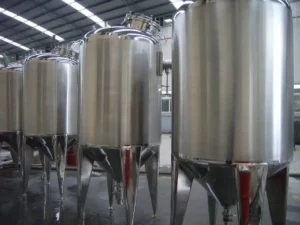
How a Glycol System Works
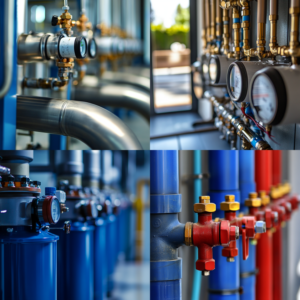
Ethylene Glycol Water: A Complete Heat Transfer Guide
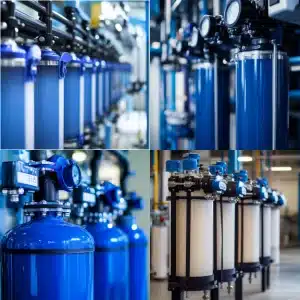
Water Filter Replacement
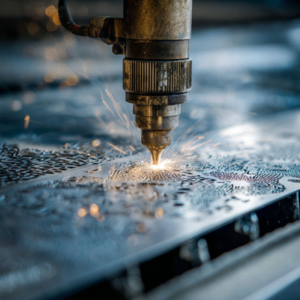
Why Use Stainless Steel Sheet Metal Fabrication?
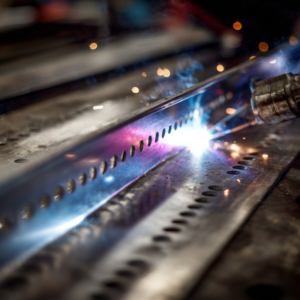
How Does Stainless Steel Sheet Metal Fabrication Work
No related articles found.
About Author

